Contents
Strawberry Kamrad Winner is a bright representative of large-fruited varieties. The outstanding size of the berries is successfully complemented by their taste. The list of advantages of the variety is not exhausted by external presentability, but it is not without significant drawbacks. Therefore, this species is rarely found in household plots.
History of origin
Kamrad Pobeditel (Kamerad Der Gewinner) is a strawberry variety, rare not only in Our Country. Therefore, there is no comprehensive data on its origin. It is only known for certain that his homeland is Germany. The variety was bred by breeders from the GDR in the mid-80s of the XX century.
Characteristics and description of Kamrad Winner strawberry variety
Kamrad Pobeditel is a non-repairable strawberry for universal use, ranked among the so-called giant varieties. It is distinguished by endurance and “plasticity”, it can adapt to different climatic conditions, without prejudice to survive the vagaries of the weather.
Appearance and taste of berries
Bushes at Kamrad Winner strawberries are powerful, sprawling, growing up to 35-40 cm in height and 45-50 cm in diameter. There are many leaves in the rosette, they are large, dense to the touch, even slightly leathery, with a pronounced “corrugation”.
On an adult strawberry bush Kamrad Winner, an average of 2-4 (rarely 5-6) peduncles is formed. The number of berries on them varies from 1-2 to 8-10 pieces.
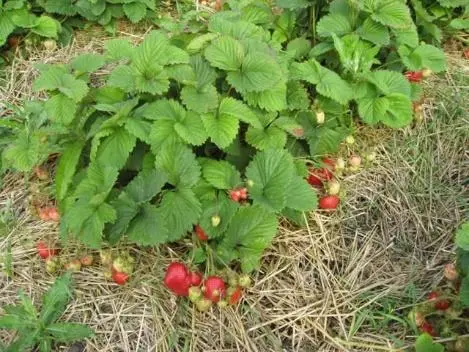
Peduncles are powerful, strong, raised above the rosette of leaves, but under the weight of berries they gradually bend, almost lying on the ground
The weight of Kamrad Winner strawberries is 40-100 g. Mostly the berries are comb-shaped, as if fused, but there are also specimens of the correct wide-cone shape. The “neck” is absent, the seeds are small, not pressed into the pulp.

There are no voids in the pulp, despite the large size of the berries
The skin of Kamrad Winner berries is colored in a “classic” strawberry-red color with a glossy sheen. The flesh is pink-red, dense, but fleshy and tender, very juicy, with a pronounced aroma. It tastes sweet, but without cloying and insipidity – there is also a slight refreshing sourness. There is nothing outstanding in this regard in the Kamrad Pobedel strawberry, but the taste is very worthy.
Flowering period, ripening period and yield
Strawberry Kamrad Winner in central Our Country is classified as a medium-late variety. However, in different regions, the ripening time of berries shifts noticeably depending on the local climate, so in the south of Our Country it is naturally considered mid-ripening or even mid-early. Strawberry Kamrad Winner blooms in the last decade of June or in early May. Harvested around mid-July.
There are few berries on strawberry bushes Kamrad Winner. This is easily explained by their large size. Accordingly, the yield is low. Under optimal conditions and with quality care, it reaches 1-1,2 kg per bush. But the average is noticeably lower – 0,5-0,8 kg.
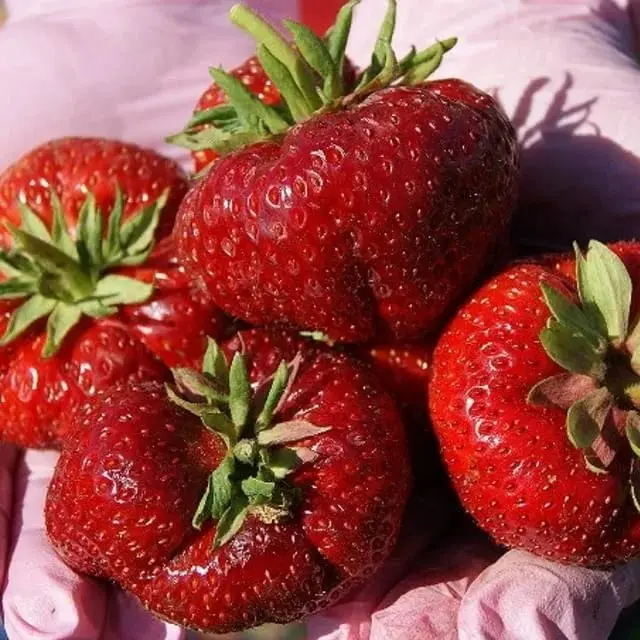
You can not count on record harvests of large berries
Frost resistance
The cold resistance of strawberries Kamrad Winner is not bad. If enough snow falls, it winters without damage at temperatures up to -30 ° C, in low-snow seasons – up to -20-25 ° C. Plants are quite hardy – even if the aerial part or the root system freezes, they recover during the next season.

In the spring, Kamrad Winner strawberries bloom quite late, which reduces the risk of buds falling under return frosts.
Disease and pest resistance
There is no data on the presence of “innate” immunity in strawberries Kamrad Winner. But the experience of gardeners shows that it is extremely rarely affected by fungi and other pathogenic microflora.
However, plantings need protection from pests that have a special love for the variety. The fruiting of strawberries Kamrad Winner is one-time, but very extended, as the berries ripen for a long time.

If preventive measures are not taken, birds, slugs, insects, rodents will have time to “taste” the crop
Advantages and disadvantages of the variety
It cannot be denied that Kamrad Pobedel strawberries have significant virtues. But she also has serious disadvantages that prevent her widespread use in personal plots.
Pros | Cons |
General endurance and “stress resistance” of plants, the ability to tolerate prolonged heat and drought | Unsuitable for cultivation on an industrial scale |
Standard farming technique | Entering into fruiting only for the second season after planting |
Good storage and portability | Demanding on the quality of the substrate and regular top dressing |
Long productive life of bushes | Low yield compared to most other varieties and hybrids, a small number of peduncles |
Very spectacular appearance and large size of berries | “Competition” from slugs, insects, birds, rodents, often having time to try the berries first |
Good taste, sweet, sugary and aromatic pulp | The rarity of the variety (means problems with the acquisition of planting material) |
The versatility of the purpose of the fruit |
|
No voids in strawberries |
|

For gardeners, strawberry Kamrad Winner is a kind of “museum exhibit”
Rules of landing
Due to the “large size” of the rosettes between the strawberry bushes Kamrad Pobeditel, a minimum of 50 cm is left, maintaining the row spacing within 50-70 cm. They are planted in an open but draft-protected place. The optimally suitable substrate is sandy loam or loam, combining nutrition with friability and “softness”. The soil should have a neutral or slightly acidic pH. In the process of digging a bed for strawberries Kamrad Pobeditel, it is desirable to “enrich” the substrate with humus (4-5 l / m²) and complex fertilizer for garden strawberries (15-20 g / m²).
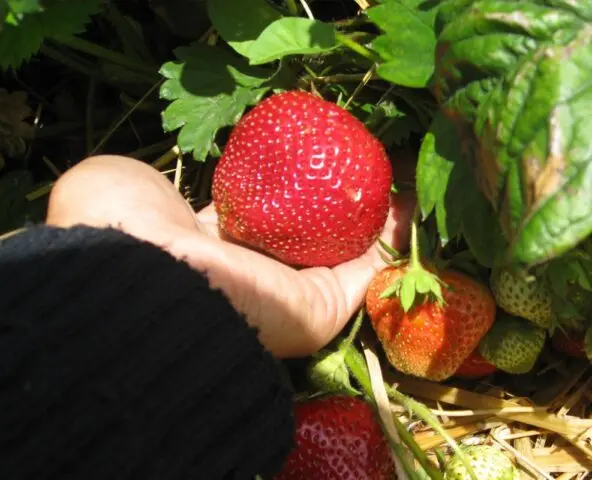
Strawberry berries Kamrad Winner with a deficit of light become noticeably smaller
Kamrad Winner strawberries are planted in holes with a depth and diameter of 15-20 cm. A handful of sand is thrown to the bottom, providing drainage. Fertile soil is poured on top, filling the hole by about a third (you can mix it with fertilizer), spill it with water. After planting, the substrate is well moistened, the soil is mulched.
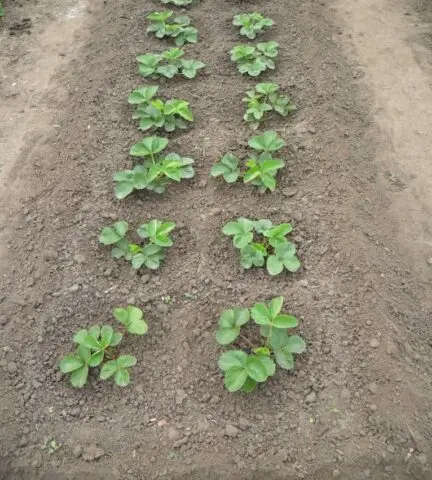
The main thing in the process of disembarkation is not to fill the “heart” with earth
Features of care
Caring for strawberries Kamrad Winner does not require much experience from the gardener. It includes:
- Watering. In hot weather, the substrate is moistened every 2-3 days, in cool weather – half as often. 5-6 liters of water are spent on a bush.
- Top dressing. 10-15 days after the appearance of the first leaves, strawberries Kamrad Winner are watered with a solution of mineral nitrogen fertilizer. At the budding stage, at the end of flowering and 2-3 weeks after harvesting, any store-bought preparation for garden strawberries is applied. To maintain soil fertility, once every 2-3 years, humus is distributed over the bed in the spring.
- Prevention of pest attacks. Insects are quite effectively repelled by spicy herbs planted nearby. Special traps are used against rodents and slugs. From birds strawberries Kamrad Winner will be protected only by a net stretched over the bed.
- Mulching. It allows the gardener to refuse to loosen and weed the beds, to increase the intervals between watering. At the same time, the mulch protects the Kamrad Pobeditel strawberries from rotting, preventing them from lying on the ground.
- Mustache removal. They are left only on the bushes chosen this season for breeding. On other bushes, the mustache is cut off so that all the nutrients are directed to the ripening of the berries.
- Preparing for winter. Includes loosening the soil, replacing the mulch, pruning the leaves, covering the soil. It is advisable to throw a bed with Kamrad Winner strawberries with coniferous branches or tighten it with agrofibre.
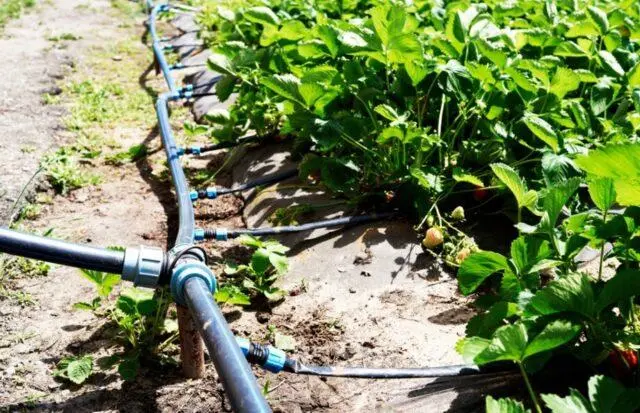
Any method of watering is suitable, excluding drops on buds, flowers and ovaries
Reproduction
For the propagation of strawberries Kamrad Pobeditel, a method provided by nature itself is used – rooting a mustache. They are formed a little, but they are very powerful and thick.
To obtain strong and hardy daughter outlets, a maximum of 2-3 mustaches are left on one uterine strawberry bush Kamrad Pobeditel, “dropping” them into pots with a fertile substrate and watering abundantly during the summer. Other mustaches and buds are cut off so that the plant does not waste strength on them.
By autumn, new outlets are separated from the mother plant. “Quality criteria” for planting material – the presence of 3-5 leaves, a diameter of at least 6-8 cm and an intact apical bud.
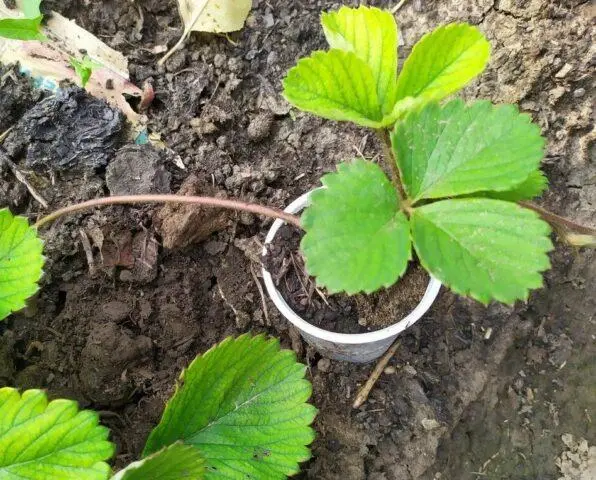
Absolutely healthy, adult (over 3 years old), high-yielding plants are chosen as “donors”
Conclusion
Strawberry Kamrad Winner is a rare variety that is more suitable for “collectors” and exotic lovers than for “average” gardeners. Among its undoubted advantages are the large size and good taste of berries, the relative ease of care and good overall endurance. However, it cannot boast of a high yield, it does not immediately enter into fruiting. The strawberry variety Kamrad Pobeditel also has other disadvantages that prevent its wide distribution in household plots.









